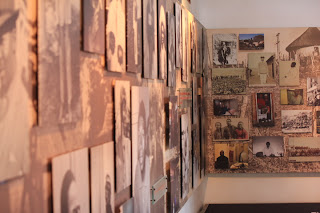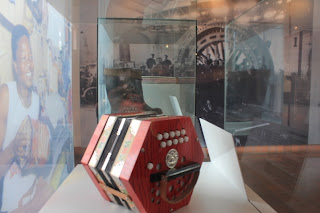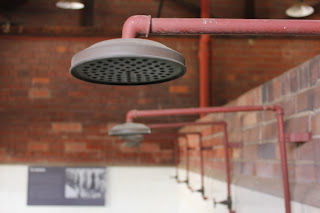The
scarcity of female art practitioners has been a lamentable feature of the South
African artscape. And this has been the case even in the days of apartheid. The
problem is also compounded by inadequate exposure of these artists; therefore a
paradigm shift needs to occur. The onus is upon creative sensibilities of present
curators to start celebrating these female voices, while recognising their
responsibility in this project of exposing female, and more specifically black
female artists. And incidentally at a recent Walkabout with crafter, Phumzile Buthelezi August, these and
other were the sentiments of both the resident artist and curator Belinda Hlaka, who has unquestionably been
at the helm of guiding the Workers’
Museum through a transformative phase, which now sees the space being a
culturally vibrant site, hosting a number of art exhibitions and events.
This
first solo exhibition titled ‘In the Depth of Beauty’, charts the
artist personal reprisal of interaction with ‘materials’, a threading of seeming disconnected collected debris into a singular
integrated expression. These artworks are a merging of practices she explored
in the past into a single body of work, which I believe is quite ‘a shedding of
one’s spirit’ and looking ‘In the Depth of Beauty’; weaving an art form that
mirrors her intrigue with the relationship between the woven form, colour, texture
and the mystery that is life. An appreciation of August’s weaved art seems to
take two forms. The first insists that the tapestries resemble something that
came off a loom rather than an easel, while the second doesn’t necessarily
object to a close imitation to a painting.
Her
authentic hand-woven paintings are reminiscent of tapestries designed and
created by traditional loom techniques yes, with grid-like structuring of
overlapping layers embodying ‘brush-strokes. Beginning with the creation of a
water-colour design on either paper, tissue paper or printmaking proofs she
collects from various sources, and continuing through the timeless process of
weaving, she crafts artworks radiant in originality and technical approach.
The urge
that accelerates her embrace of the medium is its “demand for accuracy in
combining different shades, textures and colour to recreate the artworks I choose.
I specifically chose mostly female artists like Erma Stern, for instance,
because I constantly want to understand these artists’ way of thinking and
methods of getting their colours correct. Which is a complicated task
sometimes, with limited materials and having to mix the spectrum of colour, contrast
I would perhaps find on most of those painting”.
Weaving
has that undeniable lure attributed to its versatility as well as durability,
while remaining complex enough to be a challenging exercise for any crafter. By
intricately interlacing various colourful papers and textured materials that
are cut, moved and layered, she re-integrates weaving and contemporary art to
produce works that cannot be forged, because the technique itself is a complex
and individualised experience that is hard to counterfeit.
There exists a proclivity in her work towards ‘re-compositions’ of famed paintings by master artists like Van Gogh, Erma Stern Gerald Sekoto and Matisse, artists who continue to inspire her incessant thirst for exploring various techniques and materials through her craft.
Through her patient methodology that can span “two to four weeks”, a woven rendition of Erma Stern’s original Still Life canvas comes to life on Still of Roses and Apples. These geometric abstracts cleverly woven to arouse colours that are signature Van Gogh style for instance, take hours of laborious labour she confesses. To create her replication of Peasant Woman Gleaning, makes her art religiously analogous to original prints of the chosen prototypes.
She
therefore comes to the fore as a pioneer in a new breed of weavers that re-imagine
the art world's most laborious form for the 21st century – tapestry weaving; as
a form of signature style that imbues the creator’s touch a god-like stature.
In her works, the human touch is by no means obsolete, but dynamic in that through
this medium she is capable of transcribing impressionistic works, looking at Dance with Matisse, which mimics the ‘The Dance’ to a near hyper-realistic
resemblance.
“Any
artists can work hard on a piece of work, and quite often you work very close
to the surface of your work. But once you step back, you start seeing the other
life coming together. The pixilation which I see when close to my works
disappears therefore every time I step away from my artworks.” This phenomenon
is prevalent in most art practices, from sculpture, paintings, weaving, even
photography; she admits. Her relation to the idea of art being capable of
transforming its messages, therefore meanings is summed up in a statement she
recalls as: “You don’t make art to
finish.” This has been reinforced by the fact that most viewers of certain
pieces deem them incomplete, take … for instance, the charcoal sketched
subjects in the frame become unnerving for many.
The
specificity with which through her medium of weaving is employed for art reproduction,
in that the artist has to rely on precise technical knowledge of colour
combinations, texture, the reproduced artists’ technique and “their inner
perspective of various hues and shades”, compels Phumzile to constantly study art. At present her passion for Impressionist
painting and theory are fuelling experimentation through her current body of
work, and the patience cultivated through embroidery perhaps, is sure to
produce works that will not only put female artists back on their deserved
spot-light, but elevate the cross-discipline art practices of multimedia to a
prominence unbeknown.
I had the
pleasure of a touring the exhibition under the informative guidance and
supervision of Phumzile Buthelezi August, and together with Belinda Hlaka much
about technique, inspirations and future aspirations was elaborated upon. Incidentally,
the exhibition is comprised of 30 artworks, one of which is an installation
that remains “Untitled”, as the subject matter female gender identity and
security dealt with is in continuous flux.
“Confrontationalism”
is often a preferred method of addressing gender politics on an artistic platform;
this is evinced by a plethora of recent works having relied exclusively on
vulgarity and sexualization of representation. The representation of the female
subject’s insecurities and vulnerabilities in contemporary art is a theme that
has been vastly explored, both by feminist artists and those who have often
been drawn towards capturing the female figure into a kind of "captive
body". And often than not, allusions in art towards "captive and invaded
identities" come from women artists, most of whom are women who have
experienced a certain disdain for subservience associated with womanhood.
This was
similarly the case with Phumzile, who at certain phases of her life "hated
being a woman", the common reason being a social hierarchical system that
is patriarchal and misogynist, which deems women inferior and thus incapable of
artistic expression and responsibilities. Her reaction to the unjust nature of
this disparity became an installation which can appear "defensive" at
first glance, but when you pay close attention, all facades of masculine
bravado dissipate. “The Armour”,
becomes a symbol of invisible shields carried by contemporary womanhood in
defence against an onslaught of perpetual insults and sexualised brutality
directed at their collective worth as mothers and nurturers. And as far as the
relationship of artistic occupation and social commentary is concerned, she had
a lot to say which will be posted at on a later post.
In
closing, to use the words of Courtney Martin, a renowned art teacher and
writer, “a contemporary woman artist still needs a room of one's own and, as
Woolf also urged, financial security, in order to make great art, but she also
needs "an ego of one's own," and "a network of one's own."
If her art is to get out into the world -- written about, represented by
galleries, and anointed by museums and art collectors as worthy -- she has to
be able to talk her work up, have somebody powerful willing to listen when she
does, and not face gender stereotypes that she is transgressing social norms by
doing so.”
Photographs by: Khahliso Matela
Photographs by: Khahliso Matela





































































